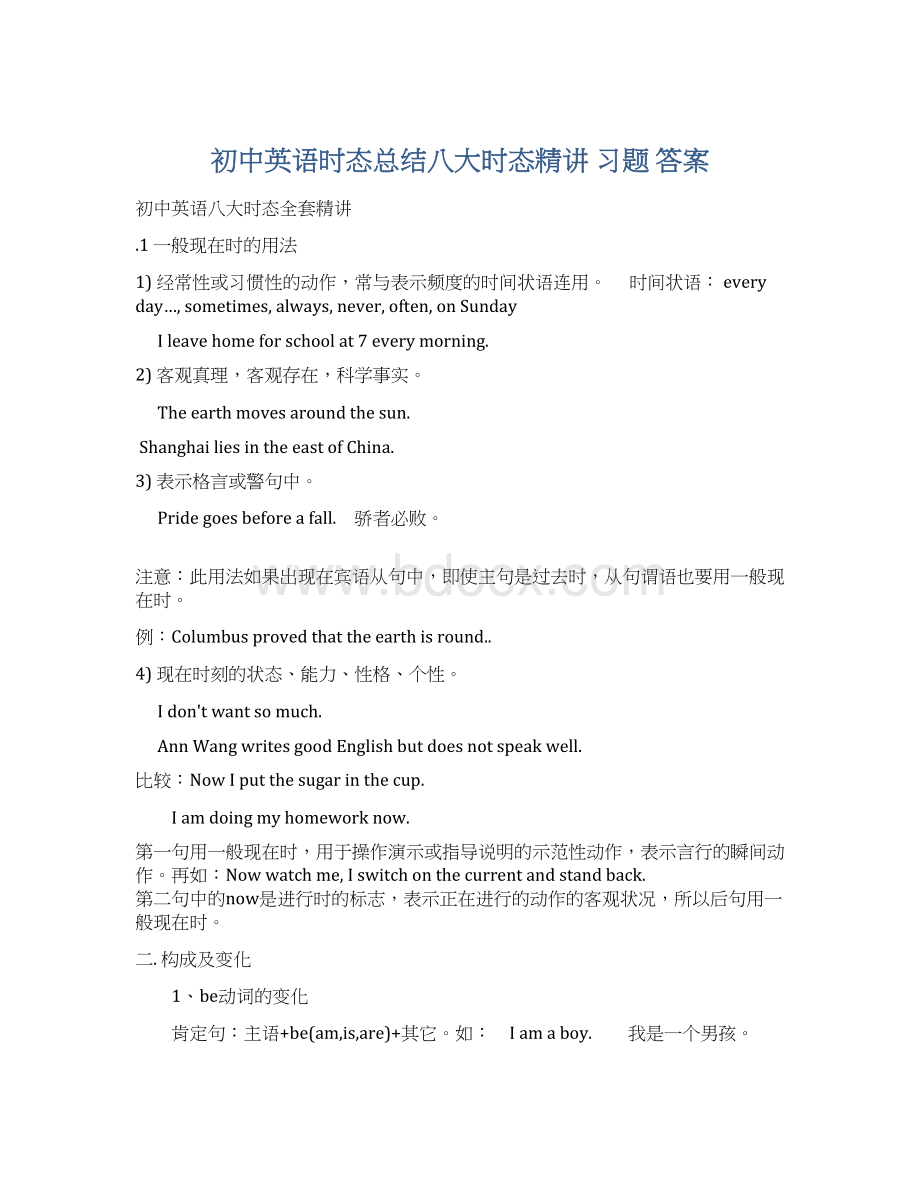初中英语时态总结八大时态精讲 习题 答案.docx
《初中英语时态总结八大时态精讲 习题 答案.docx》由会员分享,可在线阅读,更多相关《初中英语时态总结八大时态精讲 习题 答案.docx(28页珍藏版)》请在冰豆网上搜索。

初中英语时态总结八大时态精讲习题答案
初中英语八大时态全套精讲
.1一般现在时的用法
1)经常性或习惯性的动作,常与表示频度的时间状语连用。
时间状语:
everyday…,sometimes,always,never,often,onSunday
Ileavehomeforschoolat7everymorning.
2)客观真理,客观存在,科学事实。
Theearthmovesaroundthesun.
ShanghailiesintheeastofChina.
3)表示格言或警句中。
Pridegoesbeforeafall. 骄者必败。
注意:
此用法如果出现在宾语从句中,即使主句是过去时,从句谓语也要用一般现在时。
例:
Columbusprovedthattheearthisround..
4)现在时刻的状态、能力、性格、个性。
Idon'twantsomuch.
AnnWangwritesgoodEnglishbutdoesnotspeakwell.
比较:
NowIputthesugarinthecup.
Iamdoingmyhomeworknow.
第一句用一般现在时,用于操作演示或指导说明的示范性动作,表示言行的瞬间动作。
再如:
Nowwatchme,Iswitchonthecurrentandstandback.第二句中的now是进行时的标志,表示正在进行的动作的客观状况,所以后句用一般现在时。
二.构成及变化
1、be动词的变化
肯定句:
主语+be(am,is,are)+其它。
如:
Iamaboy. 我是一个男孩。
否定句:
主语+be+not+其它。
如:
Heisnotaworker. 他不是工人。
一般疑问句:
Be+主语+其它。
如:
-Areyouastudent?
-Yes.Iam./No,I'mnot.
特殊疑问句:
疑问词+一般疑问句。
如:
Whereismybike?
2、行为动词的变化
当主语为第一,二人称及复数时,助动词为do
肯定句:
主语+动词原形(+其它)。
如:
Weoftenplaybasketballafterschool.
否定句:
主语+don't+动词原形(+其它)。
如:
wedon’tplaybasketballafterschool.
一般疑问句:
Do+主语+动词原形+其它?
如:
Doyouoftenplaybasketballafterschooll?
Yes,wedo./No,wedon't.
特殊疑问句:
疑问词+以do开头的一般疑问句?
如:
Whatdoyouoftendoafterschool?
当主语为第三人称单数时,助动词为does
肯定句:
主语+动词三单式(+其它)。
如:
Heswimswell.
否定句:
主语+doesn’t+动词原形(+其它)。
如:
Hedoesn’tswimwell..
一般疑问句:
Does+主语+动词原形+其它。
如:
Doesheswimwell?
Yes,hedoes./No,hedoesn't.
特殊疑问句:
疑问词+以does开头的一般疑问句?
如:
Howdoesyourfathergotowork?
三、第三人称单数的动词变化规则(只有在第三人称为主语的肯定句中,动词才用三单式)
(1)多数动词直接加s:
runsgetslikescolletstakesplaysclimbs…….
(2)结尾是s,x,sh,ch,o,前为辅音字母,结尾加es:
watchesteachesgoesdoeswashescrossesmixesbrushes
(3)动词末尾y前为辅音:
将y改为i加es:
study→studiesfly→fliescarry→carriescry→cries
但在y前如果为元音则直接加s:
buyssays
一般过去时的用法
1)在确定的过去时间里所发生的动作或存在的状态。
时间状语有:
yesterday,anhourago,theotherday,in1982 yesterdaymorning(afternoon,evening…) lastnight(week,month,year…), amomentago,aweekago,threeyearsago… justnow,等。
Wheredidyougojustnow?
2)表示在过去一段时间内,经常性或习惯性的动作。
WhenIwasachild,Ioftenplayedfootballinthestreet.
WhenevertheBrownswentduringtheirvisit,theyweregivenawarmwelcome.
3)句型:
Itistimeforsb.todosth "到……时间了" "该……了"
Itistimesb.didsth."时间已迟了" "早该……了"
Itistimeforyoutogotobed. 你该睡觉了。
Itistimeyouwenttobed. 你早该睡觉了。
would(had)rathersb.didsth. 表示'宁愿某人做某事'
I'dratheryoucametomorrow.
4)wish,wonder,think,hope等用过去时,作试探性的询问、请求、建议等。
Ithoughtyoumighthavesome.我以为你想要一些。
5,比较:
一般过去时表示的动作或状态都已成为过去,现已不复存在。
Christinewasaninvalidallherlife.
(含义:
她已不在人间。
)
Christinehasbeenaninvalid(病人)allherlife.
(含义:
她现在还活着)
Mrs.DarbylivedinKentuckyforsevenyears.
(含义:
达比太太已不再住在肯塔基州。
)
Mrs.DarbyhaslivedinKentuckyforsevenyears.
(含义:
现在还住在肯塔基州,有可能指刚离去)
6,注意:
用过去时表示现在,表示委婉语气。
1)动词want,hope,wonder,think,intend等。
Didyouwantanythingelse?
Iwonderedifyoucouldhelpme.
2)情态动词could,would.
Couldyoulendmeyourbike?
3usedto/beusedto
usedto+do:
"过去常常"表示过去习惯性的动作或状态,但如今已不存在。
Motherusednottobesoforgetful.
Scarfusedtotakeawalk. (过去常常散步)
beusedto+doing:
对……已感到习惯,或"习惯于",to是介词,后需加名词或动名词。
Heisusedtoavegetariandiet.
Scarfisusedtotakingawalk.(现在习惯于散步)
典型例题
----Yourphonenumberagain?
I___quitecatchit.
----It's69568442.
A.didn't B.couldn't C.don't D.can't
答案A.本句虽没有明确的时间状语,但从语意上看出,在听的时候没有听懂这个动作发生在过去,因此应用过去时。
二、构成及变化
1.Be动词在一般过去时中的变化:
am和is在一般过去时中变为was。
(wasnot=wasn’t)
are在一般过去时中变为were。
(werenot=weren’t)
带有was或were的句子,其否定、疑问的变化和is,am,are一样,即否定句在was或were后加not,一般疑问句把was或were调到句首。
2.行为动词在一般过去时中的变化:
肯定句:
主语+动词的过去式.
IwatchedafilmlastSunday.
否定句:
主语+didn’t+动词原形.
Ididn’twatchafilmlastSunday.
一般疑问句:
Did+主语+动词原形?
DidyouwatchafilmlastSunday?
Yes,Idid.No,Ididn’t.
特殊疑问句:
疑问词+以did开头的一般疑问句?
WhatdidyoudolastSunday?
现在进行时
一、意义——当表示现在正在进行的动作或正在发生的事。
时间标志——now,句前的look,listen
二、构成:
be(am,is,are)+动词现在分词-ing形式
肯定句:
主语+be+现在分词V-ing(+其他)
I’mdoingmyhomeworknow.
否定句:
主语+be+not+动词-ing+其他.
I’mnotdoingmyhomeworknow.
一般疑问句:
Be+主语+动词-ing+其他?
Areyoudoingyourhomeworknow?
Yes,Iam.No,I’mnot.
特殊疑问句:
特殊疑问词+be+主语+动词-ing+其他?
Whatareyoudoingnow?
三、现在分词的构成:
(1)一般在动词末尾直接加ing,
(2)以不发音字母e结尾的动词,先去掉e,再加ing,
如skate→skatingmake→makingdance→dancingwrite→writinghave→having
ride→ridingcome→coming
(3)以重读闭音节结尾的动词,中间只有一个元音字母,词尾只有一个辅音字母,应双写末尾的辅音字母,再加ing,如:
puttingrunningbeginningstoppingswimmingshoppingjogging
sittinggettingforgettingletting
四、现在进行时的基本用法:
a.表示现在(指说话人说话时)正在发生的事情。
Wearewaitingforyou.
b.习惯进行:
表示长期的或重复性的动作,说话时动作未必正在进行。
Mr.Greeniswritinganothernovel.
(说话时并未在写,只处于写作的状态。
)
S